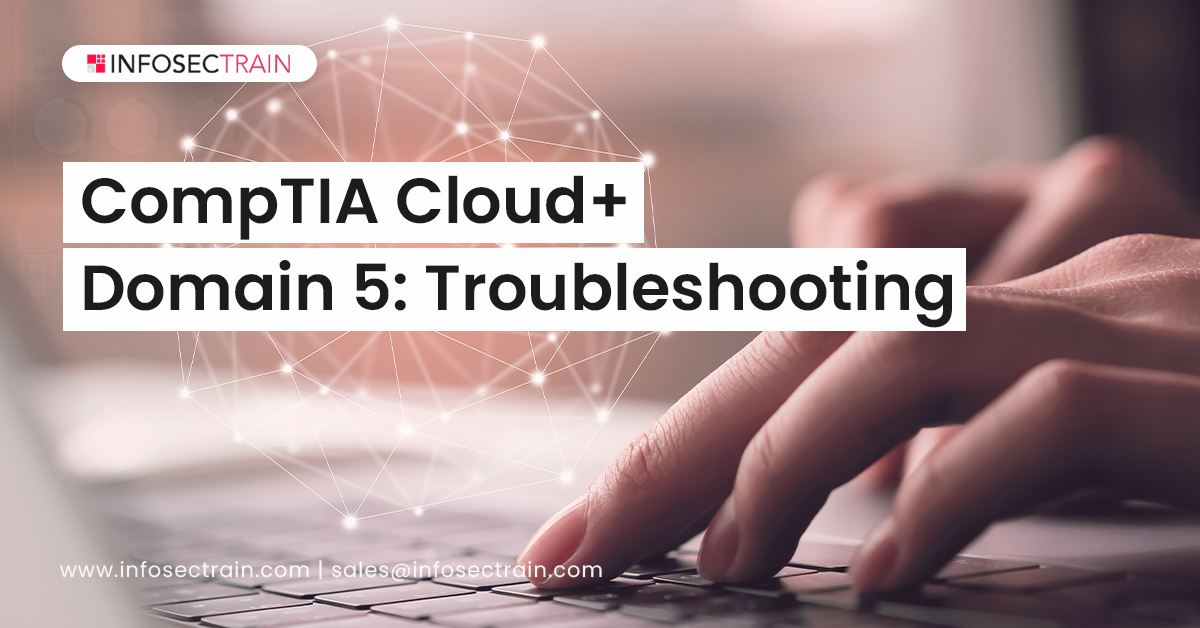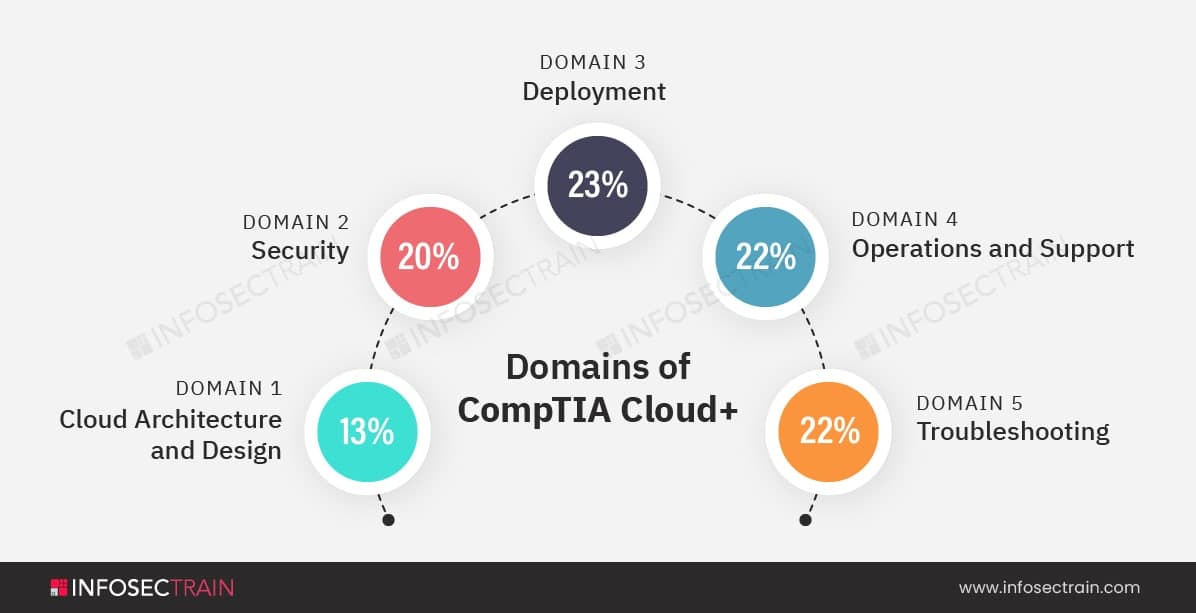CompTIA Cloud+ Domain 5: Troubleshooting

Domains of the CompTIA Cloud+

CompTIA Cloud+ certification comprises a total of five domains:
- Domain 1: Cloud Architecture and Design 13%
- Domain 2: Security 20%
- Domain 3: Deployment 23%
- Domain 4: Operations and Support 22%
- Domain 5: Troubleshooting 22%
We will discuss the fifth domain that is ‘Troubleshooting’.
Troubleshooting
Troubleshooting can be referred to as a problem-solving technique that is frequently used to fix broken goods or processes on a machine or system. In terms of Information Technology, it refers to the RCA (Root Cause Analysis) process that helps you in finding out a bug in the program. It’s a logical, methodical search for the cause of a problem in order to remedy it and restore functionality to a product or process. To diagnose the symptoms, troubleshooting is required. Just like Operations and Support, this domain also comprises the second-highest amount of weightage, that is, 22%, so it is needless to say that it is an important domain. This domain will provide an overview of topics like troubleshooting methodologies to resolve cloud issues, security issues, deployment issues, connectivity issues, performance issues, and automation and orchestration issues.
1. Troubleshooting methodology to resolve cloud-related issues
In this sub-domain, we learn about troubleshooting methodology to resolve cloud-related issues in a given scenario. We understand how to always consider corporate policies, procedures, and impacts before implementing changes:
A. Identify the problem: Question the user and identify user changes to the computer and perform backups before making changes. Inquire regarding environmental or infrastructure changes
B. Establish a theory of probable cause (question the obvious): If necessary, conduct external or internal research based on symptoms
C. Test the theory to determine the cause: Once the theory is confirmed, determine the next steps to resolve the problem. If the theory is not confirmed, re-establish a new theory or escalate
D. Establish a plan of action to resolve the problem and implement the solution.
E. Verify full system functionality and, if applicable, implement preventive measures.
F. Document the findings, actions, and outcomes throughout the process.
2. Troubleshoot security issues
In this sub-domain, we learn about troubleshooting security issues in a given scenario. We will understand privilege, authentication, authorization, security groups, keys and certificates, misconfigured or misapplied policies, data security issues, exposed endpoints, misconfigured or failed security appliances, unsupported protocols, and external/internal attacks. In privileges, we learn missing, incomplete, escalation, and keys. Security groups will take us through network security groups, and directory security groups. The topic keys and certificates are all about expired, revoked, trust, compromised and misconfigured. In data security issues, we will learn unencrypted data, data breaches, misclassification, lack of encryption in protocols, and insecure ciphers. In misconfigured or failed security appliances, we will go through IPS, IDS, NAC, and WAF.
3. Troubleshoot deployment issues
In this sub-domain, we learn about troubleshooting deployment issues in a given scenario. We will learn about connectivity issues, performance degradation, configurations, applications in containers, misconfigured templates, missing or incorrect tags, insufficient capacity, licensing issues, and vendor-related issues. In connectivity issues, we learn about Cloud Service Providers (CSP) or Internet Service Providers (ISP). Latency comes under performance degradation. The topic configurations take us through scripts. In insufficient capacity, we will learn about scaling configurations, compute, storage, bandwidth issues, and oversubscription. The topic of vendor-related issues will provide us knowledge of migrations of vendors or platforms, integration of vendors or platforms, API request limits, and cost or billing issues.
4. Troubleshoot connectivity issues
In this sub-domain, we learn about troubleshooting connectivity issues in a given scenario. We will learn network security group misconfigurations, common networking configuration issues, and network troubleshooting tools. In network security group misconfigurations, we will learn all about ACL, and inheritance. Common networking configuration issues will provide knowledge of peering, incorrect subnet, incorrect IP address, incorrect IP space, routes, firewall, Network Address Translation (NAT), load balancers, DNS records, VLAN/VXLAN/GENEVE, proxy, Maximum Transmission Unit (MTU), Quality of Service (QoS), and time synchronization issues. Routes can be default, static, and dynamic. The topic firewall will take us through incorrectly administered micro-segmentation. Network Address Translation (NAT) is all about VPN, source, and destination. In load balancers, we will learn methods, headers, protocols, encryption, back ends, and front ends. The network troubleshooting tools will explain all about ping, tracert/traceroute, flushdns, ipconfig/ifconfig/ip, nslookup/dig, netstat/ss, route, arp, curl, packet capture, packet analyzer, and OpenSSL client.
5. Troubleshoot common performance issues
In this sub-domain, we learn about troubleshooting common performance issues in a given scenario. In this, we will learn about resource utilization, application, and incorrectly configured or failed load balancing. The resource utilization will take us through CPU, GPU, memory, storage, network bandwidth, network latency, replication, and scaling. Storage can be input/output and capacity. The topic application will provide knowledge of memory management and service overload.
6. Troubleshoot automation or orchestration issues
In this sub-domain, we learn about troubleshooting automation or orchestration issues in a given scenario. This sub-domain will provide an in-depth understanding of account mismatches, change management failures, server name changes, IP address changes, location changes, version/feature mismatch, automation tool incompatibility, job validation issues, and patching failures. In automation tool incompatibility, we will learn about deprecated features and API version incompatibility.
CompTIA Cloud+ with InfosecTrain
For expert knowledge and an in-depth grasp of Cloud security, consider taking the CompTIA Cloud+ Certification Training Course from InfosecTrain. Instructors that are highly trained and experienced are in charge of this training. With our well-versed and experienced teachers, we are among the leading training providers in the globe. The courses will assist you in grasping the fundamental principles and providing a thorough understanding of the subject. This certification is well worth every dollar and minute you put into it.







 1800-843-7890 (India)
1800-843-7890 (India)